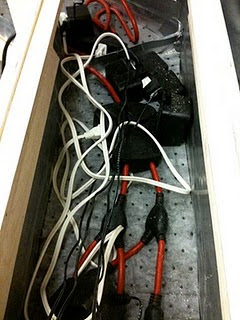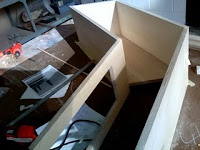After our final critique, I expected to feel a sense of relief, but instead I found myself feeling upset. I think it is fair to say that I will never again take a class like this again. It feels as if this particular learning experience is not over. The entire semester has been about learning, but ideally we would have another one or two semesters to really build on what we've learned. I know that it is not feasible for us to have more than one class like this. John mentioned that for the amount of money we were given for our projects, we would have to have a total of 96 students to break even. I know I have learned a lot in this class, and will implement the skills I have been building for the last couple of months in my future projects, but it will not be the same because of the rich learning environment and the professors as well as peers that I was able to work with.
Tuesday, December 14, 2010
Final Thoughts
This semester has been both frustrating and rewarding. This class was the most time intensive studio that I have taken thus far in my college career, and although it was not worth more credits than my other studios, it quickly became the most important because of all the learning opportunities I felt it presented. At the beginning of the year, I expected to focus on the biomimicry/ bioinspiration for our designs, but to my disappointment I found that this aspect was sometimes fit to our design after, instead of being the factor that shaped our projects. I’ve learned a lot about the design process, and how to be as effective and efficient as possible especially while working within a multidisciplinary team. I was also exposed to a lot of different technology that I would probably otherwise not have heard of, let alone had a chance to experiment with. This added onto my skill set and will definitely affect my future projects. There were frustrations along the way, particularly while designing, because a lot of the time the designs were based on the electronic components, which I did not know a lot about and could not contribute to as much as I would have liked. But these also proved to be learning opportunities for smaller, but important tasks such as wiring and soldering. Overall, I think our smart surface was successful in that we experimented with and implemented a smart material for the biomimicry story we were trying to achieve.
Final Project
For our final project, we changed the organism we were taking inspiration from. Originally, when we were trying to mimic predator- prey relationships, we were looking at garden eels that retract when they sense a shadow or predator. However, our magnets spike in response to a person. A tetraodontidae, more commonly known as the puffer fish, fit the response of the ferrofluid much better, so that became our bioinspiration.



Sunday, December 12, 2010
Wiring/Coding
The power lines needed to be placed on the bottom, before the wiring was placed on top of them. Something I forgot to mention about other precautions we took for sealing the box- We put cat litter and oil absorbent pads inside the aluminium trays, and the power lines ( 15 Amp utility extension cords for 16 DC adapters).


Coding that I took from Melany for master/slave arduinos:
#include
int ADDRESS[] = {65,42,43,60,61,62,64,65};
// these are digital pins (leds)
int led[]={2,3,4,5,6,7,8,9,10,11,12,13};
// these are analog pins (photoresistors and pir)
int photo[] = {0,1,2,3,4,5,6,7,8,9,10,11};
int ambient = 15; // this is used for the comparison of each photoresistor
int motion = 14; // pir sensor digital
int motion2 = 13; // second pir sensor
int sound = 12;
int light[12];
void setup() {
Serial.begin(9600);
Wire.begin();
for(int i = 0; i< 12; i++){
pinMode(led[i],OUTPUT);
}
for(int i = 0; i< 12; i++){
pinMode(photo[i],INPUT);
}
pinMode(ambient, INPUT);
pinMode(motion, INPUT);
pinMode(motion2, INPUT);
}
void loop() {
int compare = analogRead(ambient);
int val = analogRead(motion);
int val2 = analogRead(motion2);
int noise = analogRead(sound);
Serial.print(val);
Serial.print(' ');
Serial.print(val2);
Serial.print(' ');
Serial.println(noise);
for(int i = 0; i< 12; i++){
light[i] = analogRead(photo[i]);
}
int i= 0;
while( i < 8){
//Serial.println("val");
int value = ADDRESS[i];
Wire.beginTransmission(value);
//Serial.println(i);
if( val >= val2){
Wire.send(val);
}
else{
Wire.send(val2);
}
Wire.endTransmission();
i++;
}
if (noise >= 10){
int delayTime = 50; //the time (in milliseconds) to pause between LEDs
//make smaller for quicker switching and larger for slower
for(int i = 0; i <= 12; i++){
int offLED = i - 1; //Calculate which LED was turned on last time through
if(i == 0) { //for i = 1 to 7 this is i minus 1 (i.e. if i = 2 we will
offLED = 12; //turn on LED 2 and off LED 1)
} //however if i = 0 we don't want to turn of led -1 (doesn't exist)
//instead we turn off LED 7, (looping around)
digitalWrite(led[i], HIGH); //turn on LED #i
digitalWrite(led[offLED], LOW); //turn off the LED we turned on last time
delay(delayTime);
}
int i = 0;
while (i< 8){
Wire.beginTransmission(ADDRESS[i]);
int number = 111;
Wire.send(number);
Wire.endTransmission();
delay(150);
i++;
}
}
if( val != 0 || val2 != 0){
// for the control of leds----------------------------------
for(int i = 0; i< 12; i++){
if (light[i] > compare + 10){
digitalWrite(led[i], HIGH);
}
else {
digitalWrite(led[i], LOW);
}
}
}
else if (val == 0 && val2 == 0){
for(int i = 0; i<12; i++){
digitalWrite(led[i], LOW);
}
}
}
int ADDRESS[] = {65,42,43,60,61,62,64,65};
// these are digital pins (leds)
int led[]={2,3,4,5,6,7,8,9,10,11,12,13};
// these are analog pins (photoresistors and pir)
int photo[] = {0,1,2,3,4,5,6,7,8,9,10,11};
int ambient = 15; // this is used for the comparison of each photoresistor
int motion = 14; // pir sensor digital
int motion2 = 13; // second pir sensor
int sound = 12;
int light[12];
void setup() {
Serial.begin(9600);
Wire.begin();
for(int i = 0; i< 12; i++){
pinMode(led[i],OUTPUT);
}
for(int i = 0; i< 12; i++){
pinMode(photo[i],INPUT);
}
pinMode(ambient, INPUT);
pinMode(motion, INPUT);
pinMode(motion2, INPUT);
}
void loop() {
int compare = analogRead(ambient);
int val = analogRead(motion);
int val2 = analogRead(motion2);
int noise = analogRead(sound);
Serial.print(val);
Serial.print(' ');
Serial.print(val2);
Serial.print(' ');
Serial.println(noise);
for(int i = 0; i< 12; i++){
light[i] = analogRead(photo[i]);
}
int i= 0;
while( i < 8){
//Serial.println("val");
int value = ADDRESS[i];
Wire.beginTransmission(value);
//Serial.println(i);
if( val >= val2){
Wire.send(val);
}
else{
Wire.send(val2);
}
Wire.endTransmission();
i++;
}
if (noise >= 10){
int delayTime = 50; //the time (in milliseconds) to pause between LEDs
//make smaller for quicker switching and larger for slower
for(int i = 0; i <= 12; i++){
int offLED = i - 1; //Calculate which LED was turned on last time through
if(i == 0) { //for i = 1 to 7 this is i minus 1 (i.e. if i = 2 we will
offLED = 12; //turn on LED 2 and off LED 1)
} //however if i = 0 we don't want to turn of led -1 (doesn't exist)
//instead we turn off LED 7, (looping around)
digitalWrite(led[i], HIGH); //turn on LED #i
digitalWrite(led[offLED], LOW); //turn off the LED we turned on last time
delay(delayTime);
}
int i = 0;
while (i< 8){
Wire.beginTransmission(ADDRESS[i]);
int number = 111;
Wire.send(number);
Wire.endTransmission();
delay(150);
i++;
}
}
if( val != 0 || val2 != 0){
// for the control of leds----------------------------------
for(int i = 0; i< 12; i++){
if (light[i] > compare + 10){
digitalWrite(led[i], HIGH);
}
else {
digitalWrite(led[i], LOW);
}
}
}
else if (val == 0 && val2 == 0){
for(int i = 0; i<12; i++){
digitalWrite(led[i], LOW);
}
}
}
Saturday, December 11, 2010
Sealing the box
One of our main concerns for this project was the ferrofluid leaking ( something that had happened in our smaller module).Because the electromagnets heat up, they can easily melt the silicone and other adhesives we use to seal the box. I took on the responsibility of sealing it using multiple suggestions from both Keegan and Carlo. To address this issue, we sealed the electromagnets into their holes with epoxy clay on both the top and bottom. Keegan suggested making drip trays out of aluminium and putting them into the wooden box, underneath the electromagnets and wiring, incase the ferrofluid did leak through the epoxy. We also sealed the acrylic box itself with silicone on the inside and outside.





Friday, December 10, 2010
Building the box for the final
These are some pictures of the process of building the box. Carlo designed the box and Keegan and Josiah helped build it. I was in New York for thanksgiving break during this process, but was mainly responsible for finishing it, which involved sanding and staining the wood with polyurethane.
This design which is mainly driven by our change to a horizontal surface, also invites for interaction because of the form. I personally think it is successful and a significant improvement from our last design.





Subscribe to:
Posts (Atom)

